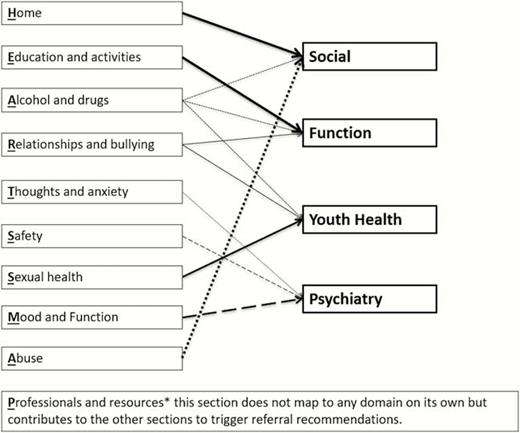-
Views
-
Cite
Cite
Erik Lamoureux, Takuro Ishikawa, Keith Yeates, Miriam Beauchamp, William Craig, Jocelyn Gravel, Roger Zemek, Quynh Doan, 72 Validating MyHEARTSMAP, an emergency psychosocial self-assessment and management tool, among youth with minor traumatic brain injuries or minor orthopaedic injuries seen in the Paediatric Emergency Department, Paediatrics & Child Health, Volume 25, Issue Supplement_2, August 2020, Page e30, https://doi.org/10.1093/pch/pxaa068.071
Close - Share Icon Share
Abstract
Fewer than 20% of the estimated 1.2 million Canadian youths living with mental health (MH) concerns receive adequate care. Paediatric emergency department (PED) visits related to MH are increasing across North America. The online self-assessment tool, MyHEARTSMAP, was developed to facilitate screening of MH concerns in the PED and general practice. MyHEARTSMAP assesses 10 psychosocial areas, mapping to four domains of MH (Psychiatry, Function, Social, and Youth Health) to provide domain-specific recommendations for patient management (Figure A).

We evaluated the convergent validity of MyHEARTSMAP when compared to established psychosocial self-assessment tools: Paediatric Quality of Life (PedsQL) and Strengths and Difficulties Questionnaire (SDQ).
We conducted a cross-sectional study among youths and parents enrolled in a larger cohort study: Advancing Concussion Assessment in Paediatrics (A-CAP). Participants were children aged 8 to 16 years old with mild traumatic brain injury or orthopaedic injury and their parents. Participants were recruited from two PEDs in Alberta and British Columbia and were asked to complete MyHEARTSMAP, in addition to the PedsQL and SDQ completed in their A-CAP study procedures. We evaluated three MH domains from MyHEARTSMAP (PSYCHIATRY FUNCTION, AND SOCIAL) to their corresponding score sections in PedsQL (EMOTIONAL, SCHOOL, and SOCIAL) and SDQ (EMOTIONAL, none, and CONDUCT and PEER). We calculated Pearson correlation coefficients between these corresponding domains and sections.
We recruited 40 child and parent pairs from Alberta and 82 from BC. The children were on average aged 12.6 years old (SD 2.2) and 44% were female. The tools screened participants as “at-risk” for various MH concerns at a rate of 26.7% to 60.8% for MyHEARTSMAP, 2.5% to 13.9% for PedsQL, and 12.3% to 16.0% for SDQ. Overall, MyHEARTSMAP was moderately correlated with PedsQL (mean ±95% CI: r = 0.405±0.151) and SDQ (mean ±95% CI: r = 0.322±0.162). Correlations (±95% CI) by MyHEARTSMAP domain for the child and parent versions, respectively, were as follows: PSYCHIATRY PedsQL (r = 0.483±0.140 / 0.509±0.134) and SDQ (r = 0.417±0.150 / 0.598±0.116); FUNCTION PedsQL (r = 0.578±0.122 / 0.455±0.143); SOCIAL PedsQL (r = 0.249±0.170 / 0.158±0.175) and SDQ (r = 0.207±0.172 / 0.067±0.178).
In conclusion, MyHEARTSMAP PSYCHIATRY and FUNCTION domains have moderate convergent validity to PedsQL and SDQ. Unlike PedsQL and SDQ, the evaluation of social issues in MyHEARTSMAP is MH-specific, resulting in low convergent validity for the SOCIAL domain.





